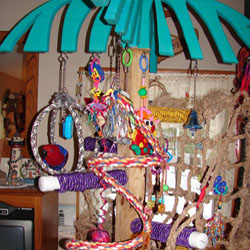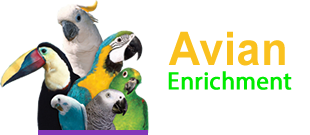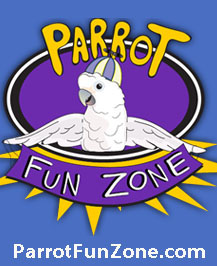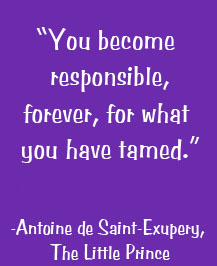Lots of Stuff for Your Birds to Do
 Parrots are active, curious and busy creatures. Wild parrots may spend hours foraging for food and water, eating, playing, flying here and there, preening themselves or each other, raising and caring for young, as well as watching for and avoiding predators. But in our home environments many individual birds may spend hours in their cages with nothing to do. And as Dr. Susan Friedman reminds us "Birds are built to behave, not be still."
Parrots are active, curious and busy creatures. Wild parrots may spend hours foraging for food and water, eating, playing, flying here and there, preening themselves or each other, raising and caring for young, as well as watching for and avoiding predators. But in our home environments many individual birds may spend hours in their cages with nothing to do. And as Dr. Susan Friedman reminds us "Birds are built to behave, not be still."
Bird owners, frustrated by their bird's behavior, often flock to bird related internet sites and discussion lists as well as to their veterinarians, to behavior consultants and to their friends searching for solutions. The most common behavioral issues include the following:
- Screaming, especially for long periods of time (more than five to ten minutes at a time)
- Feather destructive behavior
- Clinging. The bird wants to constantly be with the caregiver. The caregiver has become the entertainment center for the bird!
After all the dietary, physical, physiological and medical reasons for these behaviors have been ruled out, it appears that, for many birds, the common cause for these maladaptive behaviors is a lack of activity.
As responsible caregivers and owners, we need to be sure our birds are actively engaged. Providing foraging and other stimulating activities that involve chewing, shredding and playing, often referred to as "enrichment", are important to increase the activity levels and independent play in our birds. Some birds will need to learn to play independently with toys. Observe to make sure your birds are actually using the toys and items you place in their cage. If they do not use them, they are, as a friend says, "cage art" and the birds do not benefit. In this instance, make some adjustments and try some new ideas to get your bird engaged.
The following are various ideas that may be utilized to keep busy beaks, busy. Please note this is a general list of ideas and should be adapted as suitable for your bird. Toys and enrichment items should be appropriately sized and safe for each individual bird. It is always recommended that caregivers watch their birds as they engage in new activities.
USING FOOD ITEMS AS ENRICHMENT
Besides being a source of nutrition, food can also be fun for your bird. Foraging behavior involves creating challenging ways for your bird to acquire his diet and/or preferred treats. Birds used to living a fast food lifestyle may not immediately understand this new activity and it may be necessary at first to show your bird where the goodies are hidden. When utilizing foraging as enrichment carefully observe your bird's intake to ensure he is receiving an adequate diet. As your bird becomes more proficient at finding the items you place around the cage, you can increase the difficulty of the foraging activity.
Food enrichment suggestions:
- Weave or hang leafy greens from the cage bars or top of cage. Examples include kale, mustard greens, and dandelion greens.
- Hang carrots (with the tops) from the bars or top of the cage.
- Wrap nuts or other treats (dry cereals, dried unsulfured fruits, and dried hot peppers) in brown, white or colored paper. Place these in various areas of the cage.
- Wrap portions of your bird's daily diet in paper cups or in brown, white or colored paper. You can also use folded paper plates tied with short piece of sisal, leather strips or thinner cotton rope.
- Drill small holes in larger nuts like walnuts to make them easier to open. Let your birds chew away the shell and get at the tasty treat inside.
- Wrap treats or food in small paperboard boxes and tie them with sisal, leather strips or cotton cord.
- Cover your bird's food dish with a piece of paper or cardboard. At first you will need to make this easy. Start by placing the paper on top of the dish. Make a hole so that your bird can see the food. As the bird becomes more proficient and removing the paper, you can increase the difficulty by folding the paper over the dish and eliminating the holes.
- Skewer fresh fruits and vegetables in whole or in part on stainless steel food skewers made for this purpose and hang them in the cage. Some great ideas include: apples, oranges, grapes in a bunch, tangerines, half or one quarter of a pomegranate, corn on the cob, chunks of red or yellow bell peppers, chunks of purple cabbage or radicchio, Brussels sprouts, broccoli (with the stems and tops), and whole carrots (with the tops.)
- Hang millet sprays.
- Utilize premade foraging toys and devices such as treat and nut cages, foraging wheels and puzzle boxes to hold food and to provide additional variety and challenge.
NON-FOOD ENRICHMENT ITEMS
- Wrap beads or other non-food items in paper or un-waxed paper cups.
- Paper toy ideas:
- Place stacks of coffee filters or paper plates on a short piece of sisal, cotton or leather strip or better yet, a stainless steel toy hanger. You may want to add beads in between layers or at the top and bottom. Cut the paper half of the way through to the center. Fluff them up to form a ball. These are especially great for birds that like to over preen their feathers.
- Stuff shredded paper or dried cornhusks into a paper bag along with nuts, dried fruits, beads, etc.
- Make paper balls with a surprise in the middle.
- Provide "finger-traps" (sold as party favors) with treats or beads hidden within them.
- Hang old phone books and paperback books from the top of the cage. These are messy but FUN!
- Many birds like to play with beads. String them on short pieces of cotton rope, leather strips or sisal with knots in between. Attach to the cage bars or offer as foot toys. Be sure the size of the beads is safe and appropriate for your bird.
- Wood is a natural favorite for many birds. Here are some suggested ideas for wood enrichment items:
- Offer fresh branches from bird safe trees. Including buds, leaves and fruits can provide for hours of foraging activity. Be sure the branches have not been sprayed with pesticides or taken from the roadside. Roadside plant life is subject to the emissions and debris left behind by cars.
- If fresh branches are not available, you can add leafy greens, pieces of fruit or treats wrapped in paper or cups to the branches.
- For the heaviest of chewers, provide untreated lumber from your local home center. Most home improvement places have a "cut off bin" somewhere in the back of the lumber department where you may be able to find cut off ends of various sizes for very little cost. You can then cut these into smaller pieces and drill them so they can be strung on short chain, rope or stainless steel toy holders. Alternatively, you can simply place them in the cage as a foot toy. To increase interest, you can also drill holes in the wood to be stuffed with treats or beads.
- Purchase small or large wooden alphabet blocks made for children. Many have raised letters. You can drill holes in them and hang them. You can also offer them as foot toys or use as parts for larger toys.
- Get creative with wreaths! Large and small grapevine wreaths and willow wreaths can be found at many major craft stores during the winter holiday season. Liven up the wreaths by attaching colorful beads, leather strips, nuts, paper strips and more.
- Pine cones can be fun. Be sure to sterilize them in a 200 degree Fahrenheit oven for twenty minutes and let them cool before offering them to your bird. Pine cones can be offered as is, wrapped in other things (paper, cups, folded paper plates) or stuffed with treats (nut butters with seeds or dried fruit).
- The following is a list of plastic toys that can be provided to your parrot:
- Infant rattles and "key" rings.
- Stacking cups (you can hide treats, beads, and shredded paper in between the layers.
- Measuring spoons on a ring.
- Whiffle or waffle balls can be stuffed with paper treats, pieces of rope (with or without knots), bits of wood (a great way to recycle pieces of toys) bits of leather, beads or whatever you can fit into the holes. You can put the toys in the cage as if (foot toys) or hang them from short pieces of chain, rope, leather strips or stainless steel toy hangers.
- Other ideas include plastic soda bottle tops, very big buttons, straws tied together in the center with a zip tie.
FORAGING TRAYS, BASKETS, BUCKETS AND MORE
- Essentially you can consider any item that is bird safe and that can hold other stuff as a potential enrichment item. For example:
- Stainless steel buckets can be purchased from feed and supply stores or pet supply stores, and then filled with toys.
- Foraging trays can be made from cafeteria trays.
- Plain, uncolored baskets or those made of palm fiber can be filled with fun "stuff" (beads, shredded paper, dried cornhusk, nuts, etc.) and attached to the cage for larger birds.
- Brown paper lunch bags can be used to hide surprises.
- Re-use plastic containers, such as small condiment containers, to offer more places to forage.
- To make containers interesting add some larger river rock (check your home improvement stores for these) and include seeds, nuts, beads of various sizes and textures, pine cones, grains (wheat, spelt and kamut are great!), paper balls (large and small) and anything else your bird might like to hunt for (remember to hide some "stuff" in the paper balls too). Once full with enriching items, heavy containers may need to be placed on the bottom of the cage instead of hung.
- Another idea is to use shredded paper in a basket. Although if you have a bird that likes to nest this might not be such a good idea, especially if he or she starts to show aggressive behavior around the nest.
- Inexpensive cardboard boxes can be filled with goodies and wrapped in paper and tied with sisal, cotton or leather strips. You can even place one box inside another box. Once the birds figure out there is "stuff" inside stand back and let the paper fly!
- PVC tubes can be drilled with large holes and filled with Popsicle sticks, craft sticks and other crunchy stuff.







Comments powered by CComment